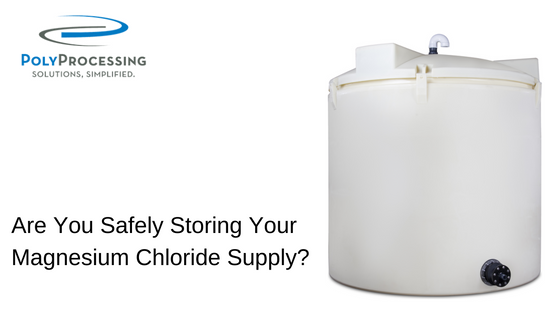Are You Safely Storing Your Magnesium Chloride Supply?

As winter approaches, you may often hear the important chemical Magnesium Chloride discussed. Magnesium Chloride is commonly used in different de-icing techniques across the northern parts of the country. But with so many people using it, it’s important that we discuss the proper storage solution.
Popular Uses of Magnesium Chloride
Magnesium Chloride is a highly soluble salt that can be extracted from seawater or brine. The substance is used in soil stabilization, wind erosion mitigation, and dust control, but is most well-known for its role in deicing. Magnesium Chloride is used to de-ice highways, parking lots, and sidewalks by helping to prevent the ice from bonding to the surfaces.
Magnesium chloride is used in three ways for pavement ice control: Anti-icing, when maintenance professionals spread it onto roads before a snowstorm to prevent snow from sticking and ice from forming; pre-wetting, which means a liquid formulation of magnesium chloride is sprayed directly onto salt as it is being spread onto roadway pavement, wetting the salt so that it sticks to the road; and pre-treating, when magnesium chloride and salt are mixed together before they are loaded onto trucks and spread onto paved roads.
Setting Up Proper Storage
Magnesium chloride is often used on streets in areas of very low temperatures, with many of these locations being at higher altitudes, in the mountains, or uphill. Our XLPE tanks are effective at storing magnesium chloride in very cold temperatures, but because of the location of the tank, there’s another important factor to consider.
Any chemical spill that occurs runs a much higher risk of contaminating the natural resources around the tank, as well as all of those that might be at a lower altitude. To prevent any ecological harm, we suggest a 110% containment system, keeping your chemicals and your environment safe.
A Full Drain for Your Tank
Poly Processing’s Integrally Molded Flanged Outlet, or IMFO system, gives the consumer a complete full drain of the magnesium chloride. The IMFO is molded while the tank is processing at the lowest point of the tank sidewall, making it a stress-free part of the tank. The flange is created from the same material as the tank and allows for access without the need for confined space entry. These tanks are cleaned using a high pressure sprayer or spray nozzle from the top of the tank, alleviating the need for personnel to enter the tank. Typically our customers clean the tanks annually based on normal usage but can be cleaned more often as necessary.
Ensuring Containment is Not An Issue
Our "tank within a tank" or SAFE-Tank storage system provides a leveraged investment that offers peace of mind and environmental care. This tank option alleviates the need to build large, high-maintenance concrete containment areas and it’s all-in-one design features a protected containment area that will safely isolate magnesium chloride from contamination, protect your employees, and protect you from environmental remediation, all within the footprint of a standard vertical tank. The SAFE-Tank is also designed to allow double contained piping to be attached to the tank as required.
Poly Processing normally equips the tanks with pvc or stainless steel fittings based on the end user’s needs.
Learn more about proper magnesium chloride storage by contacting a chemical storage tank professional today.
- November 17, 2016
- Topics: Chemicals
About Poly Processing
Posts By Topic
Tech Talk Podcast Episodes
Subscribe By Email
Recent Posts
- Maximizing Fill Efficiency: Selecting the Optimal Fill Line System
- Chemical Storage Tanks: A Quick Guide for End Users
- Popular Customization Options for Chemical Storage Tanks
- Understanding Flood Zones Under the IBC: Building Requirements and Insurance Implications
- Choosing Between Steel, Polyethylene, and Fiberglass Tanks: What You Need to Know
Tank Configurator

Find the recommended tank and system components for your chemical storage challenge.
Configure a Tank Package


